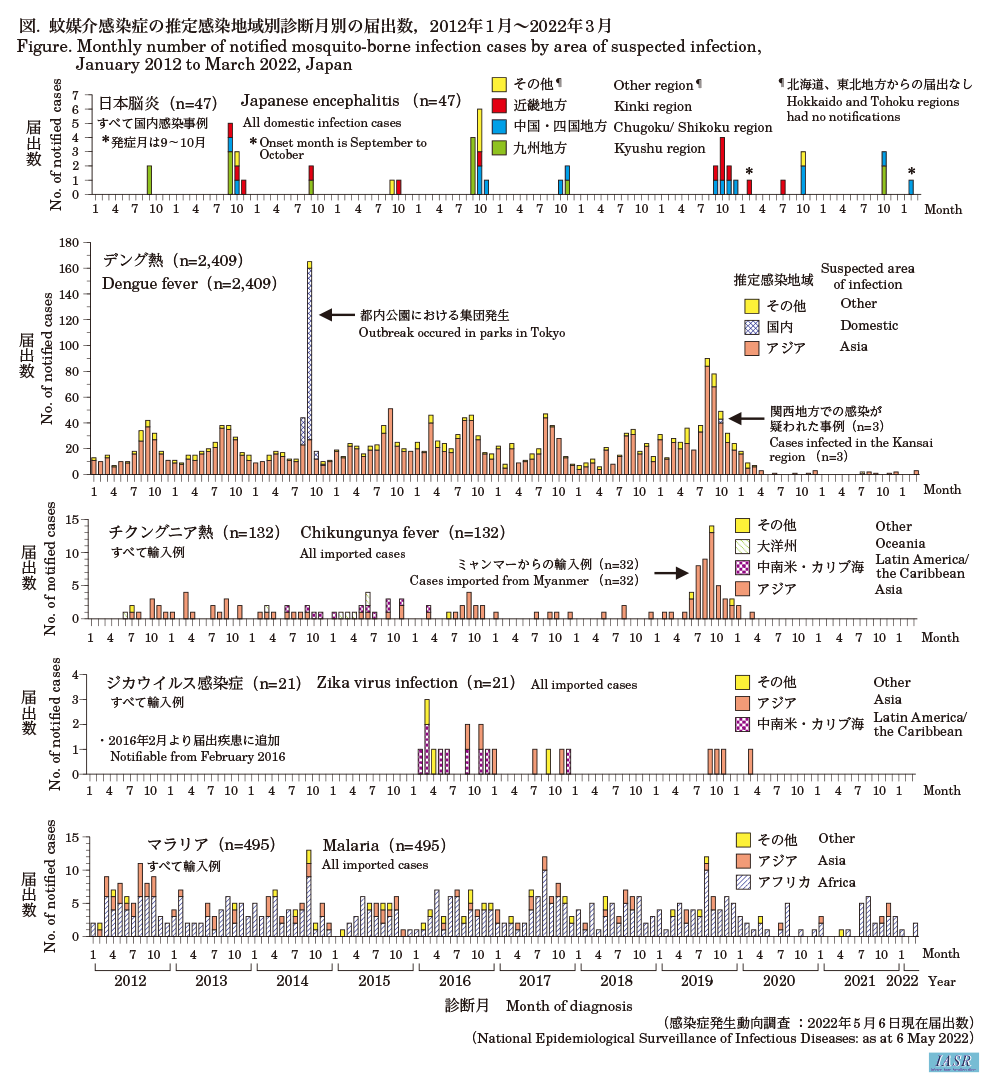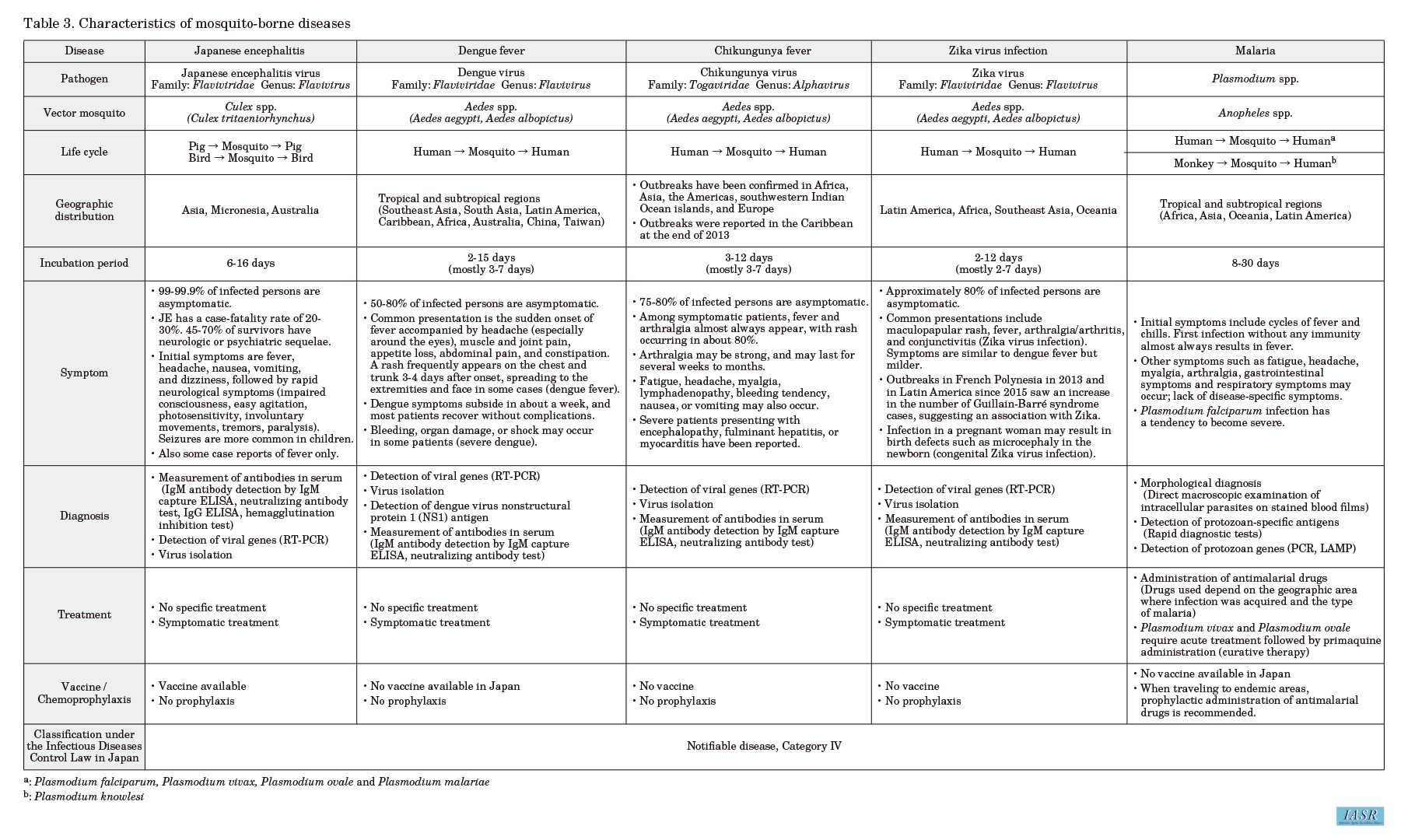IASR 43(6), 2022【THE TOPIC OF THIS MONTH】Mosquito-borne diseases, January 2012-March 2022 in Japan
PDF download(PDF:572KB)
The topic of This Month Vol.43 No.6(No. 508)![]()
Mosquito-borne diseases, January 2012-March 2022 in Japan
(IASR Vol. 43 p125-128:June 2022)
Mosquitoes are classified in the family Culicidae, and approximately 3,600 species have been recorded worldwide, with 112 in Japan (as at 2014). Many species are bloodsucking (limited to females). Of these diverse mosquito species, some are responsible for the transmission of pathogens that affect humans (Table 1). If the blood sucked by a mosquito and taken into the digestive tract contains a pathogen that is capable of infecting the mosquito, the pathogen infects the mosquito and proliferates in the gastrointestinal epithelial cells, and the infection spreads to tissues and organs in the body cavity, or, it moves to the body cavity without proliferation. In either case, the pathogen reaches the mosquito's salivary glands from the digestive tract through the body cavity within two days to three weeks, and the mosquito becomes capable of transmitting the pathogen. When mosquitoes in this state suck blood from vertebrates, the pathogen, together with the saliva, enters the blood vessels of the animal.
Characteristics of major mosquito vectors
The ability of mosquitoes to transmit a pathogen is determined not only by the type of mosquito, but also by the type of pathogen and the amount of pathogen ingested by the mosquito from the blood meal. The growth rate of the pathogen inside the mosquito varies by pathogen, and it is generally considered that the shorter the time period required for a pathogen to proliferate, the more likely it is to spread. Chikungunya virus, for example, multiplies rapidly inside the mosquito and can be detected in the salivary glands of mosquitoes within 2 days of ingestion, while West Nile virus takes 7-10 days. Factors thought to affect the magnitude of epidemics include the population density and host preferences of the mosquito, frequency of contact with the host (s), and air temperature, which affects the growth and physiology of mosquitoes. For example, Aedes albopictus, which inhabits urban environments and has a high incidence of occurrence with frequent contact with and/or opportunities for bloodsucking from humans, has a high likelihood of pathogen transmission. In contrast, Anopheles spp. mosquitoes, which have few suitable productive habitats in urban environments, is thought to have a low likelihood of spreading infectious diseases in urban areas of Japan. In addition, the growth of insects basically depends on the external environment (air temperature, length of day, etc.), and it is known that the developmental period of the larvae and the lifespan of adults change when the air temperature changes. The time it takes for Aedes albopictus to develop from a larva to an adult is 10 to 12 days in the summer (average daily temperature of around 27°C), but in early spring (April) and late autumn (October) when the temperature is lower (average daily temperature 15-20°C), it may take 30 to 50 days.
Mosquito habitats change depending on the external environment. Aedes albopictus requires an average annual temperature of 11°C or higher to establish itself, and its geographic distribution in Japan has been expanding northward with global warming. The northern limit was confirmed to be Tochigi Prefecture around 1948, Akita to Miyagi Prefectures around 1996, Iwate Prefecture in 2009, and Aomori Prefecture in 2015 (IASR 41: 92-93, 2020). Aedes aegypti, globally the main vector of dengue fever, once inhabited the Ryukyu Islands and the Ogasawara Islands of Japan, which belong to the subtropical climate zone. In Kyushu and areas north of there, which belong to the temperate climatic zone, it had been confirmed that it inhabited the Amakusa region of Kumamoto Prefecture for 9 years from 1944 to 1952. However, since the 1970s, Aedes aegypti has not been collected in Japan (including the Ryukyu Islands and the Ogasawara Islands), and its domestic distribution has not been confirmed. On the other hand, Aedes aegypti and their offspring from overseas are frequently captured at international airports in Japan. Based on the temperature at which the larvae of this species can grow, there is a possibility that it will become established in subtropical climate zones such as Tanegashima Island and southwards (IASR 41: 91-92, 2020). For other mosquitoes, natural disasters, such as tsunamis, typhoons, and floods, increase areas with stagnant water, which may become mosquito breeding grounds. After the Great East Japan Earthquake, multiple species of mosquitoes were collected from new grounds in the Tohoku region, suggesting that they were related to the tsunami disaster. There is concern for an increase in mosquito-borne diseases due to the global expansion of mosquito habitats as a result of climate change.
Subnational level health governments continuously monitor the occurrence of mosquito vectors (see p.129 of this issue). For areas considered to be suitable habitats for mosquitoes, monitoring sites are determined based on factors such as the influx of people from endemic areas, and the density, species identification, and seasonal trends of the adult mosquitoes flying into the area are investigated. Investigations of pathogen carriage in adult mosquitoes and larvae (species, specimen counts, source) may also be conducted in some cases. In addition, quarantine stations monitor international airports and seaports for mosquitoes that are not established in Japan (see p.130 of this issue).
Mosquito-borne diseases in the National Epidemiological Surveillance of Infectious Diseases system
To date, there are at least 20 known mosquito-borne diseases, of which 11 are monitored as a notifiable disease under Category IV through the national surveillance system, based on the Infectious Diseases Control Law (Table 2). The report status of the six diseases notified thus far is as follows (Figure).

In recent years, the maximum annual number of Japanese encephalitis case notifications has been about 10, all of which have been domestic infections (IASR 38: 151-152, 2017). Most of the areas where the infection was acquired have been in western Japan, which is consistent with the population density distribution of Culex tritaeniorhynchus, the main mosquito vector. Infected pigs are confirmed every year, and Japanese encephalitis virus infection continues to be possible in Japan.
The number of dengue fever cases is increasing worldwide, and this has been attributed to the concentration of human populations in urban areas in tropical and subtropical regions where dengue fever is endemic. Before 2020, the number of travelers from endemic countries to Japan and the number of travelers from Japan to endemic countries was on the rise, and the number of dengue fever cases infected abroad and diagnosed and reported in Japan (imported cases) increased, reaching a record high of 462 case notifications in 2019 (Figure , IASR 36: 33-35, 2015 & 41: 89-90, 2020). The number of notified cases of dengue fever has decreased since 2020, with 44 cases in 2020 and 7 cases in 2021. This may be due to the impact of international travel (entry/exit) restriction measures enacted against the COVID-19 pandemic. Examples of cases that spread through domestic infections include an epidemic in the 1940s attributed to importations by veterans from the Southeast Asian region that resulted in a total of 200,000 cases and an outbreak of about 160 cases in parks in Tokyo in 2014.
The endemic area of chikungunya fever is expanding globally (Table 3). The first imported case in Japan was confirmed in 2006. Since chikungunya fever was designated as a notifiable disease in 2011, 4-17 cases were reported annually from 2012 to 2018. In 2019, a chikungunya fever epidemic occurred in Myanmar, and 32 imported cases from Myanmar were notified. The number of reported cases of chikungunya fever was 3 in 2020 and 0 in 2021.
Since the late 2000s, Zika virus infection has been expanding worldwide with reports of large-scale epidemics. In Japan, the first imported case of the disease was confirmed in 2013, and 21 cases have been reported since it was designated as a notifiable disease in 2016.
The malaria parasite was once present in Japan, and it is estimated that 20,000 cases occurred annually in the 1940s. No domestic transmission has been observed since around 1960, and in recent years all reports have been imported cases (IASR 39: 167-169, 2018). The number of reported cases of malaria from 2012 to 2019 was about 40-70 per year, with 19 cases in 2020 and 29 cases in 2021.
In 2005, one imported case of West Nile fever was notified.
Imported cases of mosquito-borne diseases are expected to increase again with the relaxation of international travel restrictions put in place during the COVID-19 pandemic (see p.132 of this issue). Dengue fever, chikungunya fever, and Zika virus infection may spread domestically from imported cases and cause outbreaks. This is because mosquito vectors are widely distributed in Japan, including in urban areas, with high contact frequency with humans. On the other hand, the likelihood of such autochthonous transmission is low for malaria and West Nile fever. Mosquitoes that can transmit malaria do not live in urban areas of Japan and have low contact frequency with humans. In addition, because the viral load in human blood is low for West Nile virus, a human-to-mosquito-to-human infection cycle cannot be established. The route of infection for West Nile fever is assumed to be wild birds → mosquitoes → humans.
The following measures are important for routine responses to mosquito-borne diseases: surveillance of mosquito vectors and human cases, elimination of adults and larval sources in high-risk areas, individual prevention measures (mosquito control, vaccines), and situational awareness of overseas epidemics. Early detection and treatment of patients with mosquito-borne diseases also contribute to preventing the spread of infections. In the event of mosquito-borne disease occurrence, it is important to rapidly share information among prefectures, the national level, and residents; determine the route (s) of infection through active epidemiological investigations; and, if necessary, to conduct mosquito density surveys or control activities in areas presumed to be the source of infection.

